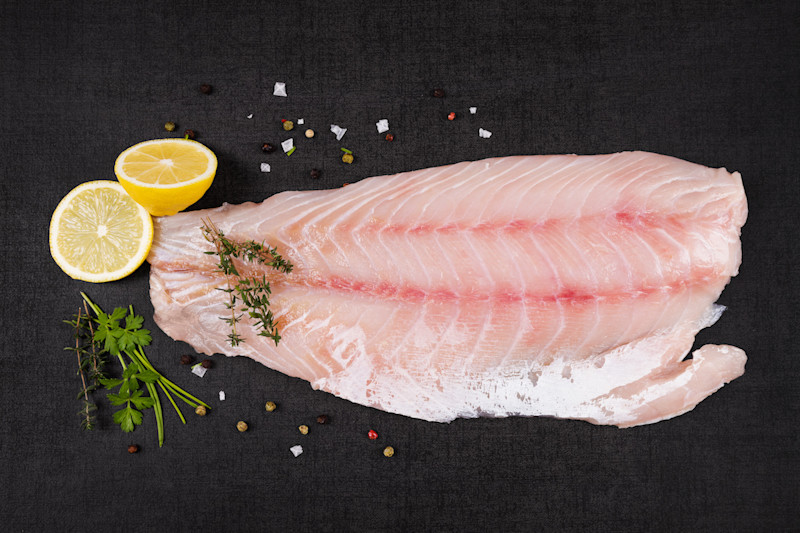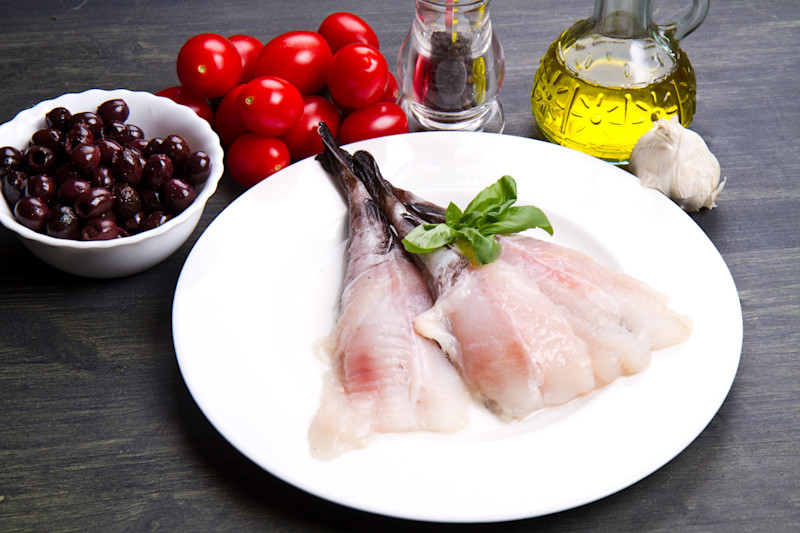Most fish are considered lean, meaning they’re less than 5 percent fat by weight. Lean fish tend to benefit from wet cooking methods, such as steaming or poaching, and rich, creamy sauces.
1. Bass can refer to hundreds of different species, including branzino (aka European sea bass or loup de mer), black sea bass, and farmed hybrid striped bass (aka sunshine bass; a cross between freshwater white bass and sea striped bass). Bass tend to have firm, mild-tasting flesh and simple skeletons that are good for filleting, with a low collagen content that can lead to bass tasting dry.

2. Mahi-Mahi (aka dolphinfish) has sweet-tasting, moist, firm-textured, pinkish flesh and a low fat content (less than 1 percent by weight). Whole mahi-mahi average 8 to 25 pounds and are available year-round, with Ecuador considered the most sustainable source.

3. Trout are typically freshwater fish. Although related to salmon, trout don’t have the same pink flesh because their diets are different. The exception is steelhead trout, which eat the same crustaceans that give salmon their pigment. Rainbow trout are the most commonly available variety, often sold whole due to their small size (about 1 to 3 pounds). They have a slightly nutty flavor and delicate texture and are available year-round. Arctic char, a type of trout are farmed in Iceland and Canada, can have just as much fat as salmon.

4. Red Snapper is a saltwater fish found off the southeastern coast of the US. It’s usually sold as skin-on fillets to show that it’s genuine: real red snapper has red skin and flaky white flesh that tastes mildly sweet. (“Pacific red snapper” is actually a type of rockfish.) Averaging 2 to 6 pounds, red snapper can be baked, broiled, grilled, poached, or steamed whole or as fillets, and the bones and head are good for fish stock. Red snapper from the Florida Gulf, Texas, Louisiana, and Alabama are considered more sustainable than red snapper from Mexico and is available July through September. Try grilled whole red snapper stuffed with cilantro and thinly sliced limes.

5. Tuna is the most popular seafood in the US, but about 95 percent of what we eat is precooked and canned. Tuna’s high myoglobin content gives its raw flesh a deep red color and meaty flavor. Tuna is best cooked to around 120°F, when not quite opaque, and can become mushy if held at 130 to 140°F. The most important commercial species of tuna are albacore, which averages 10 to 40 pounds, has light brown or pink-red flesh, and is available May through November; bigeye, which averages 20 to 50 pounds and is available July through October; and yellowfin (aka ahi), which has darker flesh than albacore and is available June through September. Treat tuna like you would an amazing wagyu steak—they deserve that respect. Tuna is a delicate meat with very little fat. Encrusting it with sesame seeds protects the meat during the sear and adds a nutty flavor as the seeds toast. Searing happens quickly with tuna—only 30 seconds on each side over medium heat. If the pan gets too hot, add a touch of cold oil to keep the sesame seeds from burning.

6. Cod are saltwater fish that can be found from the Atlantic, caught in New England, to the Pacific. Both varieties are mild in flavor with flaky white flesh. Atlantic cod averages 2.5 to 10 pounds and has less moisture, firmer texture, and sweeter flavor than Pacific cod. It’s available January through March. Pacific cod averages 5 to 15 pounds and has a delicate texture. It’s is available year-round, with the most sustainable option from Alaska. Cod works well baked, broiled, or in a chowder. Try substituting cod for chicken in piccata.

7. Halibut is the largest of the flatfish, a type of sideways-swimming fish with both eyes on one side of the head. It has firm white flesh with more collagen than other fish, so it’s more forgiving in terms of dryness. Found in the North Atlantic and northern Pacific, halibut can be very large so it’s commonly sold as frozen (or previously frozen) fillets. Pacific halibut averages 10 to 60 pounds and is available March through November. Try pan-seared halibut with brown butter and sage.

8. Flounder is a family of abundant saltwater flatfish with mild, light flavor that includes sole, turbot, fluke, and Dover sole. Flounder are versatile fish that can be broiled, sautéd, stuffed and baked, or steamed whole. Like all flatfish, flounder have both eyes on one side of their heads. Summer flounder (aka northern fluke) has edible skin, delicate texture, and is available April through May. Try breaded, pan-fried flounder with lemon and fresh herbs.

9. Pike is a type of lean, bony freshwater fish found in North American lakes, including the Great Lakes. One of the leanest fish, pike has a flaky, dry texture that’s good baked with stuffing or sauce or poached. Pickerel is the smallest fish in the pike family and is especially lean and firm. Try pickled pike with red onions.

10. Catfish is a freshwater fish that’s often farmed and sold skinned because its scaleless skin can be difficult to remove. Catfish gets its name from the barbels (fleshy filaments) hanging from its mouth, which look like cats’ whiskers. It’s in the same family as carp, but catfish’s simpler skeletal structure makes it easier to fillet. Channel catfish is the most common species in the US, where it’s available year-round. Mildly sweet catfish fillets can be fried, baked, grilled, poached, sautéed, or in a stew. Try breaded, fried catfish served with coleslaw.

10. Perch, confusingly, refers to many different species, of which the only “true” perch are yellow perch and common perch. Yellow perch is native to eastern North America and weighs about 1 to 2 pounds. Farmed yellow perch is available year-round and has pink flesh with a sweet flavor and flaky texture. Common perch is similar to yellow perch but greener in color and can weigh up to 6 pounds. “Pacific ocean perch” is actually a type of rockfish with a nutty-sweet flavor and firm texture, available year-round from California to Alaska. Try lightly flouring yellow perch fillets before pan-frying and serving with risotto.

12. Monkfish (aka anglerfish) averages 7 to 15 pounds, about 1 to 4 pounds of which is boneless, dense tail meat typically sold as skinned fillets, since the skin can make monkfish taste tough when cooked. It has a sweet flavor and firm texture that’s often compared to lobster or scallops.

13. Tilapia is a name for several species of freshwater fish found in waters above 60°F and commonly farmed in the US. Tilapia typically has firm, white flesh, with a somewhat bland flavor. Fast-growing tilapia can be harvested within 8 to 10 months. Try Filipino nilasing na tilapia, or “drunk” tilapia—whole fish briefly marinated in Shaoxing wine, coated with flour and cornstarch, and then fried until crispy.

14. Swordfish are distinguished by the “swords,” or bills, that stick out from their upper jaws, which they use to slash at prey. These large fish (averaging 50 to 200 pounds) have dense, meaty, almost boneless flesh that can be white or pink.


0 Comments for “14 Types of Lean Fish”